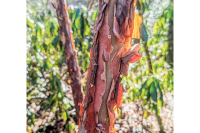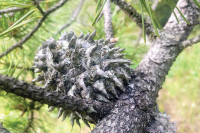Limestone ‘sink’ is just over the mountain
Editor’s note: This article first appeared in a January 2005 edition of The Smoky Mountain News.
“If it form the one landscape that we …
Are consistently homesick for, this is chiefly
Because it dissolves in water …
What I hear is the murmur of underground streams,
what I see is a limestone landscape.”
— “In Praise Of Limestone,“ W.H. Auden (May 1948)
The topography and vegetation here in our part of Western North Carolina is among the most varied and attractive in North America. Most all of the distinctive natural features of the southern highlands — from spruce-fir and upland hardwood coves to highland bogs, escarpment gorges, and grassy balds — can readily be sought out and explored here in the far southwestern counties of the state.
When the bats leave the belfry: Fungus cuts down bat population, sparks speculation on species, ecosystem future
 Sarah Davis loves bats. They’ve been the wintertime residents of Linville Caverns for as long as she can remember, a marker of the seasons she looks forward to each year. The cave, a commercial cavern near Marion, has been in Davis’ family since the 1940s — she and the bats go way back.
Sarah Davis loves bats. They’ve been the wintertime residents of Linville Caverns for as long as she can remember, a marker of the seasons she looks forward to each year. The cave, a commercial cavern near Marion, has been in Davis’ family since the 1940s — she and the bats go way back.
“There would be hundreds of them in the winter, and I absolutely loved them,” Davis recalls.
My journey to the center of the Earth, and back
 By Stephanie Wampler • Columnist
By Stephanie Wampler • Columnist
Our Saturday morning cave adventure started out innocently enough. We would need flashlights. Check. I had purchased three apiece, plus four spare AAA batteries. Change of clothes. Check. Layers for warmth, since it was after all underground and therefore likely to be chilly. Check. Hiking boots. Water bottle. First aid kit, including snakebite venom extractor just in case we did happen to run across an angry and poisonous snake two miles deep into the cavern. (You never know. It could happen.) In any event, first aid kit, check. Sandwiches. Chocolate chip cookies. Check plus. They were very good cookies. I put a few in a bag to take into the cave and left the rest in the car for when we came out. We were packed and ready. The possibility that we might need anything else, like rope or a ladder or a safety net, never occurred to me.
From the darkness to the light – literally
 Legend has it that curious fishermen watching trout seemingly disappear into Humpback Mountain back in 1822 discovered an entrance into what is now known as Linville Caverns. Henry E. Colton of eastern North Carolina and once a state geologist for the state of Tennessee was one of the discoverers. Colton wrote about the discovery in an 1858 issue of the NC Presbyterian: “… we emerged into an immense passage, whose roof was far beyond the reach of the glare of our torches, except where the fantastic festoons of stalactites hang down within our touch. It looked like the arch of some grand old cathedral, yet it was too sublime, too perfect in all its beautiful proportions, to be anything of human …”
Legend has it that curious fishermen watching trout seemingly disappear into Humpback Mountain back in 1822 discovered an entrance into what is now known as Linville Caverns. Henry E. Colton of eastern North Carolina and once a state geologist for the state of Tennessee was one of the discoverers. Colton wrote about the discovery in an 1858 issue of the NC Presbyterian: “… we emerged into an immense passage, whose roof was far beyond the reach of the glare of our torches, except where the fantastic festoons of stalactites hang down within our touch. It looked like the arch of some grand old cathedral, yet it was too sublime, too perfect in all its beautiful proportions, to be anything of human …”









